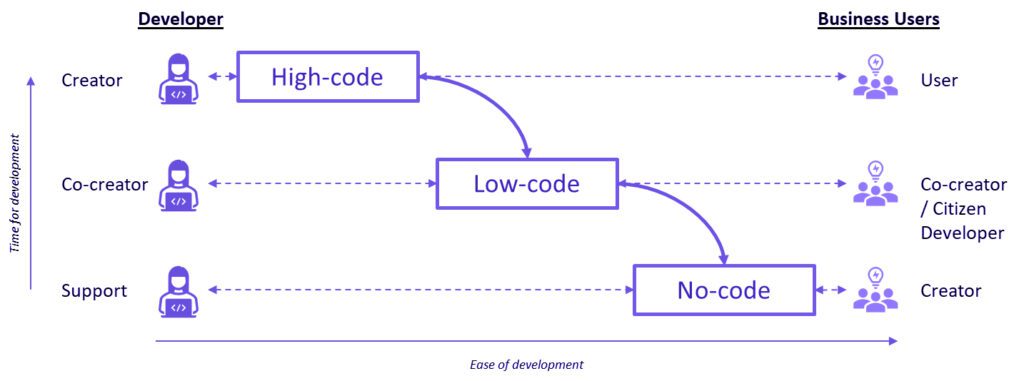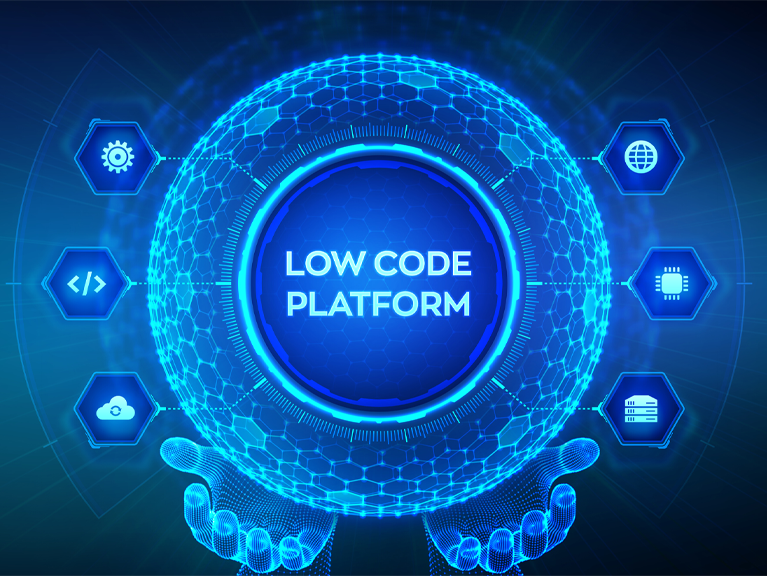Summary
Simplification and efforts optimization has always been the underlying driver behind all human endeavours. This holds true for almost everything that we set out for. At first the process seems complex and requires the maximum amount of efforts, but slowly and gradually the process becomes simple and requires just the optimum efforts due to the standardization and continuous improvement. This thought can be furthered into technology arena as well – with the level of technological advancements that we have been witnessing in the recent past. Over the years, the technologies – catering to different aspects of our lives – have changed by leaps and bounds and have made our lives even simpler.
Target Audience
The content of this write-up is apt for consumption by anyone wishing and willing to explore what low-code is, how it is changing the application development process, and why its adoption is bound to grow in times to come.
Let’s imagine some mouthwatering scenarios…

Scenario 1: Imagine you want to eat Pizza, but you don’t know how to make one, what would you do?
You will order it – as simple as that.
But then there are other overheads that you must take care of, and multiple decision you must make upfront:
- Choosing the vendor (Domino’s, Pizza Hut, or multiple others) which offers what you are craving for at that moment.
- Choosing the size, flavour, toppings etc.
- Since the pizza will be ready-made, it will cost more, plus you will have to pay for all the customizations you want – all within the permissible limits.
- You will have to pay for delivery (may be implicit or explicit).
- And, then there will be other factors which will determine whether you savour your pizza to your content or not, such as:
- The time taken to deliver
- The temperature when delivered or when you finally get to eat it
- Adherence to your choice of toppings / customizations
- …
- And once you are done eating, there might be some leftovers and/or wastage which you must deal with.
Scenario 2: Now imagine, you want to eat Pizza, but you do not want the hassle of ordering it and all associated overheads, so you decide to make it yourself.
Making pizza is a specialized skill, and comes with its own task list:
- Source all ingredients for dough, sauces, toppings etc.
- Buy/borrow/rent the infrastructure: Oven, pots and pans, chopper / shredder etc.
- Make dough for pizza base, make pizza sauces, chop and shred all toppings (veggies, cheese etc.)
- Put everything together ensuring everything is in delectable proportion, and bake it
This sound little too demanding for a pizza, doesn’t it?
But what if you are given a fully functional kitchen loaded with all what you need to make the pizza of your liking, and you just need to pay for what you use?
Sounds like best of both worlds, doesn’t it?
This is what low-code does. Low-code development platforms are comparable to the kitchen where you can bake pizza of your choice. You get all what you need – and much more – to make a gourmet pizza – the infrastructure, the ingredients, the recipes, and guidance of a connoisseur which will not let you go wrong. And the best part is that you get all of it at fraction of the cost of setting it up on your own – from scratch.
Low-code defined…
Low-code is an application development approach – enabled by the low-code development platforms / technologies – which reduces the development time, and efforts significantly by bringing together all the requisites in pre-built / pre-configured / configurable / customizable form.
With low-code development platforms, you do not ever need to start from scratch. You do get access to required components / templates / modules for which the complex task of coding / configuration / compilation has already been done, you just need to choose the ones which fit your requirements and put them together to build your application.
Moreover, if you are too fond of writing your own code and have it your way, low-code development platforms allow for that as well – you get the flexibility to write your own code to extend / build upon what is already available.
How low-code is different from high-code and no-code
Before talking about the difference, let’s first understand what high-code and no-code are.
High-code development is the traditional way of application development where:
- developers write lines of code as per the requirements,
- testers test it for defects, and
- release teams compile and deploy when everything falls in place.
Business users mostly play the role of SME as well as end-user and have no say in how the development is done.
As far as no-code development is concerned, it is true to its name and requires no coding whatsoever to build your version of application – and this is what makes no-code development ideal choice for business users while professional developers can always be reached out for support, if needed.
No-code platforms have a defined output, and although they give you various templates / options to choose from, the output will always be aligned to the definition.
With that said, no-code development offers very limited customizations – only those which are already provisioned for and can be achieved via configurations. Some of the examples (just examples, no promotions) could be:
- Creating your website on wix.com.
- Building your webstore on Shopify using its inbuilt features for product catalogue, checkout, and payment processing.
- Using HubSpot for marketing automation, email campaigns, and customer support while leveraging its out-of-the-box integration with Shopify.
- Process automation across multiple applications using Celigo – a process orchestration platform.

Low-code development sits in the middle and empowers both developers and business users alike. With low-code, developers’ lives have become very easy because much of their job has already been done by the low-code platforms (this actually means that someone else has already done the complex job of writing and testing the code). And contrary to high-code development, the low-code platforms have enabled the business user to play an active (co-creator) role in the application development because now it’s more logic driven and less technology driven.
With all that put in perspective, it’s safe to say that High-code is the air that low-code and no-code development breathe. You don’t see the high-code that has gone behind enabling low-code and no-code development platforms – but it’s there, and indispensable. High-code development goes behind building the ready-to-use components which low-code / no-code platforms offer. High-code development has always existed, and will continue to exist, however, in a covert manner – considering the limelight that low-code and no-code development are getting.
Why low-code?
Change is the order of time!
Organizations have been working towards digital transformation for years, however, over the past couple of years, there has been an unprecedented emphasis on digital transformation of businesses across industries. This can primarily be attributed to the changing market dynamics in the wake of Covid-19 pandemic, young start-ups disrupting the playing field, and GenZ driving the market demands.
Businesses are forced to constantly evolve themselves, and their offerings, so that they can stay ahead of the competition or at least remain in the race. It’s now, more than ever, that businesses are feeling the need to innovate, and come with the offerings that customers are willing to pay for. They want to be out there in the market as quickly as possible, and with the experience that can keep customers coming back for more.
This is where low-code development comes as a savior. There are my low-code technologies available in the market, such as:
- Low-code Application Platforms (LCAPs): OutSystems, Mendix, Appian, ServiceNow, Power Apps etc.
- Business Process Automation (BPM): OutSystems, Creatio, Appian, Kissflow, Zoho, Pegasystems etc.
- Robotic Process Automation (RPA): Automation Anywhere, Blue Prism, UI Path, Power Automate, Pegasystems etc.
- Multi-experience Development Platforms (MXDP): OutSystems, Firebase, Salesforce Lightening etc.
- Integration Platform as a Service (iPaaS): Celigo, Mulesoft, Workato, Zapier, Boomi, Tray.io, Jitterbit etc.
Low-code application platforms (LCAPs) are projected to be the largest component of the low-code development technology market, growing 25% to reach nearly $10 billion in 2023, while the worldwide market for low-code development technologies is projected to total $26.9 billion.
LCAPs offer a suite of modules, tools, components, actions, and processes, which automate the end-to-end application development and lifecycle management. With such level of automation, development time and efforts reduce significantly, and quality improves due to standardization.
Following are few common tools, and feature which come with almost all the LCAPs:
- An integrated development environment where the developers can build applications using visual modelling tools and interfaces.
- Out-of-the-box reusable features, components, widgets
- Pre-built apps and templates ready to be (re)use and can be customized if needed.
- Infrastructure needed to host and run software applications.
- CI/CD tools to navigate through the entire application lifecycle.
- Real-time application performance monitoring.
- Pre-built connectors with external systems, as well as ability to consume / expose APIs
- Reporting and analytics
- Inbuilt security and compliances
While low-code tools or platforms automate large part of the development process and reduce the amount of technical expertise required, they as well pave the way for democratization of the software application development – wherein business domain experts actively take part in the development process. They empower technical and non-technical staff to participate in application development, giving more autonomy to functional groups, and reducing the burden on the professional developers.
Gartner predicts that by 2026, developers outside formal IT departments will account for at least 80% of the user base for low-code development tools, up from 60% in 2021
There are myriad benefits offered by low-code application platforms (LCAPs), major ones being:
- Faster time to market, and eventually to value,
- Modern application architectures,
- Easy and seamless integrations,
- Continuous and smooth deployments,
- User experience that stays with the users, and brings them back,
- Impenetrable security, and compliance,
- Reusability and scalability
- Operational efficiencies
- Reduced overall IT cost
Where do we see low-code moving?
Low-code technologies are already disrupting the market of conventional development technologies, and the simple reason is that they offer just what is highly desired across the board:
- less spend – on multiple resources with different skills, training etc.,
- more productivity – with less time spend on development, and
- quicker time to market – with reduced development cycles and quick deployments.
They also enable easy integration with external systems to share relevant information to and from, thus expanding the horizon for innovative solutions as needed.
Long due that we truly appreciate the promises that these next generation application platforms make – the promises to bring about the business value, ability to respond to changing requirements quickly through shrinking development cycles, and modern and robust architecture to complement existing application landscapes. The low-code technologies are here to stay, and lead from the front.
As per the recent reports from Straits Research “the global low-code development platform market size is estimated to reach an expected value of $148.5 billion by 2030”.
About Author
Avinash is serving as Solution Architect for Digital Solutions at Zimetrics Technologies. With him, he brings extensive experience in solving business problems of varied complexity across different industries and domains. He is an expert when it comes to end-to-end solutioning, business process management, and low-code / no-code technologies.

